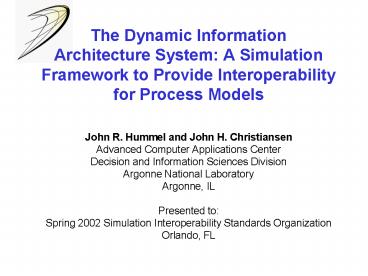The Dynamic Information Architecture System: A Simulation Framework to Provide Interoperability for - PowerPoint PPT Presentation
1 / 23
Title:
The Dynamic Information Architecture System: A Simulation Framework to Provide Interoperability for
Description:
John R. Hummel and John H. Christiansen. Advanced Computer Applications Center ... DIAS is an Object-based Software Framework for Modeling and Simulation Applications ... – PowerPoint PPT presentation
Number of Views:66
Avg rating:3.0/5.0
Title: The Dynamic Information Architecture System: A Simulation Framework to Provide Interoperability for
1
The Dynamic Information Architecture System A
Simulation Framework to Provide Interoperability
for Process Models
- John R. Hummel and John H. Christiansen
- Advanced Computer Applications Center
- Decision and Information Sciences Division
- Argonne National Laboratory
- Argonne, IL
- Presented to
- Spring 2002 Simulation Interoperability Standards
Organization - Orlando, FL
2
Outline
- What is DIAS?
- Examples of DIAS Applications
- Summary
3
What is DIAS?
- DIAS is an Object-based Software Framework for
Modeling and Simulation Applications - The DIAS Software Infrastructure Allows Many
Disparate Simulation Models and Other
Applications to Interoperate to Address a Complex
Problem Based on the Context of the Specific
Problem - DIAS is Subject Domain Independent the
Integration of Models and Applications Gives it a
Specific, Subject Domain Flavor (e.g. DEEM,
IDLAMS, HealthSim, IOA, )
4
What is DIAS?(Cont.)
- DIAS has been Awarded a US Patent (6058387) and
is Provided License-Free to US Govt. Agencies and
Their Contractors - DIAS has been Selected by the US Environmental
Protection Agency as their Simulation Framework
for Environmental Modeling Applications
5
What are the Main Components of a DIAS
Application?
- Software Objects That Represent the Real-World
Entities in the Problem Space - Objects are
Designed from a General Perspective in Order to
Maximize Reuse - Internal or External (i.e. Legacy) Simulation
Models and Other Applications That Express the
Dynamic Behaviors of the Domain Entities - DIAS
Can Integrate Existing "Legacy" Models in
Virtually Any Software Language - Infrastructure Tools that Enable
Context-Dependent - Spatial Representation of Object Attributes (e.g.
Point, 2-D, 3-D) - Multiple Representations of Object Behaviors
6
What are the Main Components of a DIAS
Application?(Cont.)
- APIs have been Developed to Facilitate the
Integration of Models for non-DIAS Experts - The Unique DIAS Infrastructure Makes It Feasible
to Build and Manipulate Complex Simulation
Scenarios in Which Many Thousands of Objects Can
Interact Via Dozens to Hundreds of Concurrent
Dynamic Processes
7
Q Why is Simulation Context So Important?A
Entities Can be Simulated from Different
Perspectives
The Ultimate Goal is to Have a Single Object
Design that can Adapt to these Different
Perspectives
8
DIAS Embraces and Extends the Object Paradigm
- Key Tenets of the Object Paradigm in Software
Engineering are Embraced by DIAS - Encapsulation Objects Manage Their Own
Attributes and Dynamic Behaviors, Thereby
Promoting Clean, Modular Design - Inheritance Object Subclasses Can "Inherit"
Attributes and Behaviors From Parent Object
Classes, Thereby Promoting Code R reuse and
Extensibility
Reuse
9
DIAS Embraces and Extends the Object
Paradigm(Cont.)
- DIAS Extends the Object Paradigm by Abstraction
of the Objects' Dynamic Behaviors - the WHAT Is
Separated From the HOW - DIAS Object Definitions Contain an Abstract
Description of the Behaviors (the WHAT) the
Objects can Manifest, but No Details (the HOW) on
how to Implement them - Separate Models / Applications Carry the Details
of how to Implement Object Behaviors - Models Are Linked to Appropriate Domain Objects
on the Fly, to Meet Specific Needs of a Given
Simulation Context - Leading to Even Greater
Flexibility and Extensibility
10
DIAS Embraces and Extends the Object
ParadigmContext-Dependent Implementation of the
How
11
DIAS Embraces and Extends the Object
ParadigmImplementing Different Spatial
Representations
12
DIAS Embraces and Extends the Object
ParadigmImplementing Different Spatial
Representations
13
A Large (and Growing) DIAS Object
LibrarySupports Construction of New Simulation
Systems
14
Outline
- What is DIAS?
- Examples of DIAS Applications
- Summary
15
DIAS Evolution and Sponsor Applications
16
DIAS Applications
17
DIAS Applications IOA Integrated Ocean
Architecture
18
DIAS Applications An IOA Application for Camp
Le Jeune, NC
Here, wave spectra
generated by WAM are
used as boundary
conditions for STWAVE
Nearshore
Shallow Water Sea
State Dynamics
Offshore
STWAVE
Deep Water
Sea Surface
or
WAVE SPECTRUM
WAVE SPECTRUM
Sea State
Tide and Wind
REFDIF
Dynamics
Effects
WAM
PCTIDES
19
Benefits of the Integrated Ocean Architecture
20
DIAS Applications HealthSim A Health Care
Simulation System
21
Outline
- What is DIAS?
- Examples of DIAS Applications
- Summary
22
Summary
- DIAS is a Subject Domain Independent,
Object-based Software Framework for Modeling and
Simulation Applications - DIAS Extends the Object Paradigm by Abstraction
of the Objects' Dynamic Behaviors - the WHAT Is
Separated From the HOW - The Context of the Simulation Determines Who
Does What to Whom and How
23
For More Information
- DIAS Homepage http//www.dis.anl.gov/DIAS/
- Call or e-mail
- John R. Hummel (630.252.7189), jhummel_at_anl.gov
- John H. Christiansen (630.252.3291), jhc_at_anl.gov































